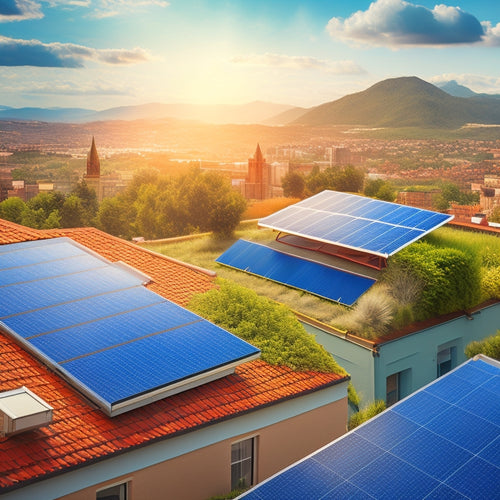
Safe Paints for Earth-Loving Home Renovators
Share
You're likely unaware that the paint on your walls can harbor toxic chemicals like titanium dioxide and ethylene glycol, contributing to poor indoor air quality and environmental pollution. Eco-friendly paint options, such as those from Benjamin Moore, Farrow & Ball, and Valspar, offer a safer choice, meeting strict environmental standards. When selecting paint, evaluate its volatile organic compound (VOC) levels, durability, and scrub resistance, as low VOC levels release fewer harmful chemicals into the air. By choosing sustainable paint brands and formulations, you can create a healthier indoor environment and support planet-conscious practices - and there's more to uncover about making the best choice for your home renovation.
Key Takeaways
- Choose eco-friendly paints with low VOC levels, durability, and scrub resistance to reduce environmental footprint and improve indoor air quality.
- Look for brands like Benjamin Moore, Farrow & Ball, and Valspar that meet strict environmental standards and incorporate solar-powered solutions.
- Opt for natural paint alternatives made from plant-based pigments, biodegradable additives, and non-toxic ingredients for healthier indoor environments.
- Prioritize sustainable brands that focus on eco-friendly formulations, transparent ingredient lists, and planet-conscious manufacturing processes.
- Consider DIY natural paint recipes using natural pigments, binding agents, and solvents to ensure alignment with eco-friendly values and customization.
Choosing Eco-Friendly Paint Options
When it comes to painting your home, you're likely to brush up against a multitude of options, but choosing eco-friendly paint is a smart move that can considerably reduce the environmental footprint of your renovation project.
In fact, many companies are now incorporating solar-powered solutions renewable energy sources to reduce their carbon footprint, and it's crucial to reflect on the environmental impact of your paint choice.
Eco-friendly brands like Benjamin Moore, Farrow & Ball, and Valspar offer a wide range of colors and finishes that meet strict environmental standards.
When selecting an eco-friendly paint, think about the color selection process, which often involves evaluating the paint's volatile organic compound (VOC) levels, durability, and scrub resistance.
Look for paints with low VOC levels, as they release fewer harmful chemicals into the air.
Understanding Paint Chemical Composition
When you pick up a can of paint, you're holding a complex mixture of chemicals that will eventually adorn your walls.
You need to understand that paint is composed of various chemical components, including binders, solvents, pigments, and additives, which can affect its performance and safety.
As you consider eco-friendly options, it's crucial to investigate renewable energy sources and sustainable practices in other industries, like electric vehicle charging, to make informed decisions about the paints you choose for your home renovation project.
Paint Chemical Breakdown
As you investigate the world of paint, you're likely to encounter a multitude of chemicals that make up the final product.
These chemicals can have a significant impact on both human health and the environment. Understanding the chemical breakdown of paint is vital in making informed decisions about the products you use in your home renovation.
| Chemical Component | Function | Environmental Impact |
| Titanium dioxide | Pigment, UV resistance | Contributes to paint toxicity, potential water pollution |
| Ethylene glycol | Solvent, flow improvement | Toxic to humans and aquatic life, contributes to air pollution |
| Diisononyl phthalate | Plasticizer, flexibility | Linked to reproductive issues, contaminates soil and water |
| Calcium carbonate | Filler, opacity | Relatively harmless, but can contribute to water pollution |
| Silica | Thickening agent, texture | Can cause respiratory issues, contributes to air pollution |
When selecting paints, consider the chemical composition and its potential environmental impact to make a more sustainable choice.
Volatile Organic Compounds
You've likely noticed that some paints have a strong, pungent smell that can trigger headaches or dizziness. This is due to the presence of Volatile Organic Compounds (VOCs), which are chemicals that evaporate quickly and release harmful fumes into the air.
VOCs can negatively impact indoor air quality, exacerbating respiratory issues and contributing to environmental pollution. In fact, many eco-conscious consumers are now opting for electric vehicles, which not only reduce carbon footprint but also offer significant cost savings through federal EV tax credits.
Some key facts about VOCs in paint include:
- VOCs are regulated by government agencies, with limits on the amount allowed in paint
- Low-VOC or VOC-free paints are available, offering a safer alternative
- VOCs can linger in the air for days or even weeks after application
- Proper ventilation and use of respirators can minimize exposure to VOCs
Natural Paint Alternatives Exist
Ditching synthetic paints can be a challenging task, but switching to natural alternatives is getting easier by the day. You're no longer limited to conventional options, as innovative brands are now offering eco-friendly solutions.
Natural paint alternatives are made from plant-based pigments, which provide lively colors without the toxic chemicals. Furthermore, these paints often feature biodegradable additives, reducing their environmental impact.
By choosing natural paints, you're not only creating a healthier indoor environment but also supporting sustainable practices. With the growing demand for eco-friendly products, you can expect to find more affordable and effective natural paint options on the market.
Many green energy sources, such as hydroelectric power plants, are also being employed to power EV charging stations, further reducing our reliance on fossil fuels.
Additionally, some countries are leading the way in sustainable energy adoption, making it easier for individuals to make environmentally conscious choices.
Low-VOC Paint for Healthy Homes
Natural paints are just one aspect of creating a healthy indoor environment. When it comes to choosing the right paint for your home renovation, you need to take into account the environmental impact and indoor air quality.
Low-VOC (Volatile Organic Compound) paints are a great option. They reduce the amount of harmful chemicals released into the air, improving indoor air quality and minimizing respiratory problems.
Additionally, integrating solar power into your home renovation can further reduce your carbon footprint, much like solar power integration in EV charging infrastructure.
Low-VOC paints have lower odor levels, making them ideal for people with sensitivities or allergies. They're also better for the environment, as they reduce the amount of pollutants released into the atmosphere.
Sustainable Paint Brands Matter
You're probably wondering what makes a paint brand sustainable.
It starts with eco-friendly formulations that prioritize the environment, which means you should look for brands that use non-toxic ingredients only.
A planet-conscious manufacturing process is also essential, so be sure to research a brand's practices before making a purchase.
Eco-Friendly Formulations Matter
One essential aspect of selecting safe paints for home renovation is the eco-friendly formulation of the paint itself.
You want to guarantee that the paint you choose not only looks great but also aligns with your values of reducing your environmental footprint.
When evaluating eco-friendly formulations, look for:
- Sustainable sourcing of raw materials
- Eco label certifications, such as Greenguard Gold or EU Ecolabel
- Low VOC (volatile organic compound) content
- Water-based or plant-based formulations that reduce reliance on fossil fuels
Non-Toxic Ingredients Only
As you investigate deeper into the world of eco-friendly paints, it becomes clear that the ingredients used in their production play a critical role in guaranteeing a safe and healthy indoor environment.
You'll want to opt for sustainable paint brands that prioritize non-toxic ingredients, free from harsh chemicals and volatile organic compounds (VOCs).
Look for paints that employ natural, non-toxic pigments derived from plants, minerals, or recycled materials.
Additionally, confirm the binders used are safe and eco-friendly, such as natural latex or plant-based polymers.
Planet-Conscious Manufacturing Process
While eco-friendly ingredients are essential, it's equally important to take into account the environmental impact of a paint's manufacturing process.
You want to guarantee that the brand you choose not only uses non-toxic ingredients but also follows sustainable and ethical production practices.
When researching sustainable paint brands, look for companies that prioritize:
- Sustainable sourcing of raw materials, reducing the demand on natural resources
- Energy-efficient facilities and equipment to minimize carbon footprint
- Ethical production practices, guaranteeing fair labor conditions and minimizing waste
- Transparency in their manufacturing process, providing you with a clear understanding of their environmental impact
DIY Natural Paint Recipes
How can you create a safer, more sustainable painting experience without sacrificing color and quality?
By making your own natural paint, you can control the ingredients and guarantee they align with your eco-friendly values. Start by mixing natural pigments like plant-based dyes, earth oxides, or natural clays with a binding agent like natural latex, starch, or egg yolks.
Experiment with color mixing to achieve your desired hues. Add texture options like sand, sawdust, or natural fibers to create unique finishes. You can also use natural oils like linseed or hempseed oil as a solvent.
With a little creativity, you can create a custom, eco-friendly paint that's perfect for your home renovation project.
Frequently Asked Questions
Can I Use Eco-Friendly Paint on Previously Oil-Based Painted Walls?
When shifting from oil-based to eco-friendly paint, you'll need to employ specific preparation techniques, like sanding and priming, to guarantee a smooth application; then, you can confidently apply eco-friendly paint using specialized application methods for a successful, toxic-free finish.
Are Natural Paints Suitable for High-Moisture Areas Like Bathrooms?
You're wondering if natural paints can handle high-moisture areas like bathrooms. Look for paints with moisture-resistance certifications, ensuring paint durability. These eco-friendly options will provide a healthy, sustainable choice for your bathroom renovation, giving you the freedom to create a space that's both beautiful and breathable.
Do Sustainable Paints Require Special Cleaning Products?
Coincidentally, you'll find that most sustainable paints don't require special cleaning products; instead, you can use gentle cleaning methods to remove paint residues, as they're formulated to be easy to clean and maintain, giving you the freedom to focus on your eco-friendly renovation.
Can I Mix and Match Different Eco-Friendly Paint Brands?
When mixing and matching eco-friendly paint brands, you'll want to verify brand compatibility to maintain ideal paint performance; check the ingredients and VOC levels to assure a harmonious blend that meets your environmental standards.
Are Natural Paints More Prone to Fading or Color Changes?
As you dip your brush into the world of eco-friendly hues, you wonder if natural paints will fade like a sunset on a summer evening. Rest assured, natural pigments generally boast better color stability, ensuring your walls remain lively and true to their original tone.
Related Posts
-

Why Merge Earth's Heat With Sun's Energy?
You're about to utilize the full potential of renewable energy by combining the Earth's natural heat with the Sun's a...
-

What Roofing Materials Best Protect Our Planet?
As you consider the environmental impact of your building, you're likely to find that the roofing material you choose...
-

Transform Your Outdoor Space With Recycled Plastic Lumber
By incorporating recycled plastic lumber into your outdoor design, you're not just building a deck or installing a fe...


